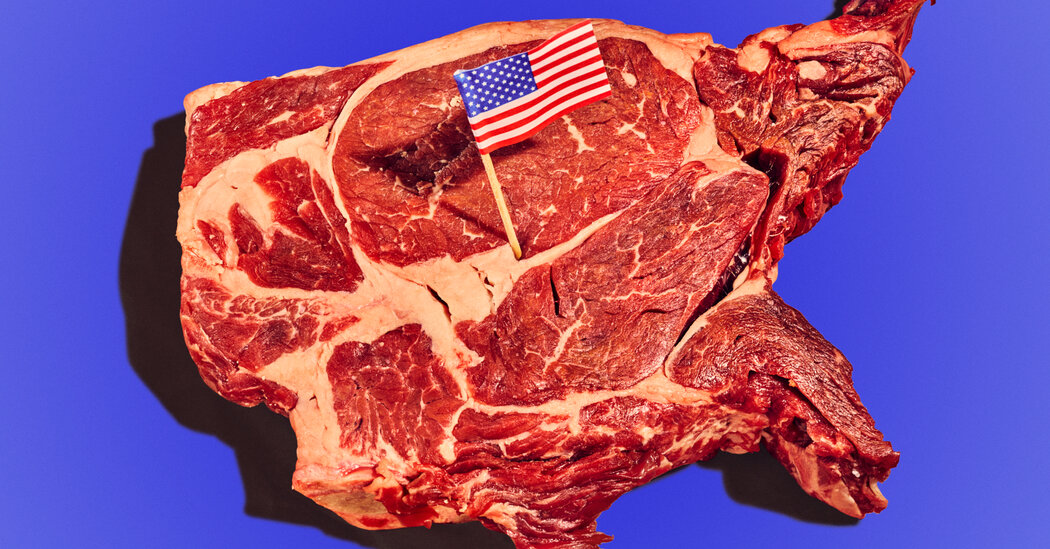Meat’s reputation has taken a pounding over the last few years. Blamed for poor health, implicated in climate change and attacked for cruelty to animals, it played the villain while plant-based burgers, grain bowls and four-star vegan dishes took their star turn.
No more. Meat has muscled its way back to the center of the plate.
Sales of beef, pork, lamb, poultry and other meat in the United States hit a record $104.6 billion last year, according to a March report by FMI, the nation’s largest food retail trade group, and the Meat Institute, the top meatpacking and processing trade organization.
On average, Americans ate 2 percent more meat last year than the year before, according to one report. And the number of consumers who said they were trying to eat less meat fell to 22 percent, the lowest level in at least five years.
The politics of the moment play a big part. With support from both the farm-to-table faithful on the left and self-described carnibros on the right — not to mention a Make America Healthy Again movement that lionizes beef tallow and hunting — meat has inspired a bipartisan potluck.
“The demonization of meat is over,” said Chris DuBois, a senior vice president at the market research company Circana. “Meat has huge tailwinds going, and honestly that’s a shock because for a long time all we talked about was headwinds.”
Inflation-weary couples are staging fancy steak nights at home. Fast-food restaurants are swapping seed oil for beef tallow. The salad chain Sweetgreen has added steak to its increasingly meaty menu. Riding the popularity of last year’s cheeseburger flavor, Doritos recently introduced chips that taste like Korean barbecue.
In a country shopping for convenient, less-processed ways to satisfy its obsession with protein, meat provides an answer, particularly for aging baby boomers and the millions of Americans trying to counter the loss of muscle mass that can come with taking GLP-1 drugs. Younger people looking for convenience are also eating more meat.
“There is this perception that protein is an end-all, be-all to health, and meat is an immense shortcut,” said Melanie Zanoza Bartelme, an associate director at Mintel who analyzes the global food and drink market.
America’s love affair with meat began in earnest in the years after World War II, when suburban families spent Sundays watching Dad grill steaks. The pace only accelerated when fast food took off in the 1970s. In the ensuing decades, meat’s popularity rose or fell with the changing pace of the economy, health advice and dining trends.
Five years ago, meat hit a wall. Plant-based burgers were catching on, and the amount of meat the average American ate per year started to wane. By 2022, it was down to 264 pounds — a drop of 10 pounds in two years.
Editors at the recipe website Epicurious announced in 2021 that beef would be banished from all future content, citing its contribution to greenhouse-gas emissions. That same year, the chef Daniel Humm of Eleven Madison Park in New York City — considered one of the world’s top restaurants — retooled his $335 tasting menu to eliminate animal products. Restaurants of all sorts added vegetarian dishes for environment- and health-minded diners.
Meat’s rebound surprised researchers like Lucy Woods, a senior consumer insights manager at the food conglomerate Cargill, who wrote its 2025 protein report for North America. The number of Americans trying to get more protein into their diets has jumped 13 percent since 2019, the report said. But not just any protein: The research showed that nearly 98 percent of households buy meat and 73 percent consider it a healthy choice, up 10 percent since 2020.
“People are prioritizing meat,” she said.
The switch has generational quirks. Young influencers on the carnivore diet, a meatier cousin of the keto regimen, post videos of plates filled with steak and sticks of butter. Millennials are increasingly eating duck, in dishes like carnitas or Chinese barbecue made in an air fryer. The poultry industry reports that Generation Zers have a huge appetite for chicken, by far the top-selling animal protein in the United States, especially when it aligns with their beliefs about corporate responsibility and sustainability — or comes dunked in ranch dressing.
The restaurant landscape is also changing. Sales at Texas Roadhouse, with its value-priced sirloin steaks and hand-cut, 20-ounce rib-eyes, grew by almost 15 percent last year. That was enough to knock Olive Garden from its longtime perch as the nation’s top casual dining chain, according to data from Technomic, a food-service research company.
Fogo de Chão, a Brazilian chain where waiters circle the room offering slices of salt-seasoned beef, lamb and other roasted meat, opened 10 restaurants in the United States in 2024 and plans a dozen more this year, mostly on the coasts. The restaurants, which also serve extensive salad offerings. have become popular with flexitarian Gen Z diners who value choice, culinary adventure and minimally processed food.
“Beef never went away,” said Barry McGowan, the chain’s chief executive. “It’s the rediscovery that whole protein is nutritionally dense and is good for you.”
The emphasis on meat has reached high-end restaurants known for nonmeat dishes. Kismet in Los Angeles, which calls itself a “James Beard-nominated vegetable-loving restaurant,” staged a pop-up steakhouse in January and February.
The chef Victoria Blamey typically used red meat as a supporting player at Blanca, in Brooklyn, N.Y., but on one of her last tasting menus she slipped diners a slice of aged rib-eye with cordyceps, an exotic fungus. (The restaurant closed unexpectedly this month.)
The pendulum, she said, has swung back from more vegetable-forward dining. “Everyone was going crazy with seaweed a few years ago, and now no one is talking about it,” said Ms. Blamey, who grew up in the beef-loving culture of Chile and Argentina. “It’s the steakhouse vibe: ‘I really don’t care about plant-based. I just want to have my steak and drink my Burgundy.’”
For many conservatives, pushing back against the liberal green agenda is part of the attraction of conspicuous meat consumption.
Make America Healthy Again loyalists are using beef tallow as a rallying cry in their fight against highly processed foods. They’re following the lead of the nation’s health secretary, Robert F. Kennedy Jr., who visited a Steak ‘n Shake restaurant in March to celebrate the chain’s decision to “RFK” its French fries by using beef tallow instead of seed oil.
Although nutrition experts say heavy consumption of animal fat can increase the risk for heart attacks and other problems, Mr. Kennedy and others insist that beef tallow, which is rendered fat from a cow, is healthier than processed oils.
Both Elon Musk and Joe Rogan, the nation’s top podcaster, have proselytized for a diet of mostly meat. “The best I ever felt — like, literally, the best I ever felt, all throughout the day, was when I was on the carnivore diet,” Mr. Rogan told his millions of listeners in 2023. (The diet excludes all vegetables, fruits, grains and nuts.)
In Manhattan, a cradle of liberalism, business is strong at the butcher shop Hudson & Charles in the West Village and its sister shop on the Upper West Side. Some customers are simply looking for grass-finished meat from a butcher who knows where the animal came from and can offer cooking tips. Others have gone full carnivore.
“We have this one guy who eats seven pounds of beef liver a week,” said J. Fox, who owns the business with his husband, Kevin Haverty. “Another guy buys suet, and he has us cut it into bite-size pieces and then sits outside and eats it.”
The owners don’t talk politics in their stores, but Mr. Fox says he has noticed that “a lot of the carnibros tend to lean more right. But then you have the extra-left who meet in the middle with the MAGAs.”
Tanya and Jason Watson met on a Facebook group called the Meating Places in 2023. Both are Christians in their 40s, with politics that lean libertarian. And they eat meat almost exclusively.
When they married last year in Virginia Beach, their wedding cake was made from ground beef, covered with tallow whipped to look just like fluffy cream-cheese frosting.
Mr. Watson has autoimmune issues. After trying several different ways of eating to feel better, he landed on a nearly all-meat diet. “I’m not anti-vegan or anti-left,” said Mr. Watson, who works in digital sales. “I’m more like, this is what I like and this is what works for me.”
On the other side of the country and the political spectrum, Cassidy Engfer started the carnivore diet four months ago on the advice of her doctor. A parks and recreation supervisor for Mariposa County in California, she also owns a business called Yogasemite, which mixes yoga with day hikes in Yosemite National Park.
Ms. Engfer and the Watsons may not agree on politics, but they do on meat. She explains it like this: On the left are people who eat with the health of the planet in mind, buying food at local farmers’ markets, composting and embracing the nose-to-tail ethos. On the right are the “don’t tread on me” crowd, who prize family tradition and less-processed food — much of which they might grow or hunt themselves.
“Where we meet in the middle,” Ms. Engfer said, “is that meat is what feels right in a lot of our bodies.”
Mr. Humm, the Eleven Madison Park chef, is not reading too much into this meaty moment. “Food culture is always shifting, but I don’t think these recent trends mean a rejection of plant-forward cuisine in the long run,” he wrote in an email.
Others see the change as a seminal. Nicolette Hahn Niman, the author of the 2014 book “Defending Beef,” is a former vegetarian who once worked as a lawyer for Mr. Kennedy’s Waterkeeper Alliance in its fight against pollution from animal waste. She lives on a Northern California ranch with her husband, Bill Niman, the grass-fed-beef pioneer who played an essential role in the birth of California cuisine.
“I am passionate about this whole idea that beef has been unfairly vilified,” she said. Beef’s resurgence, she added, is part of a newfound interest in questioning every part of the American food system.
“We have to smash something.”
Follow New York Times Cooking on Instagram, Facebook, YouTube, TikTok and Pinterest. Get regular updates from New York Times Cooking, with recipe suggestions, cooking tips and shopping advice.
Kim Severson is an Atlanta-based reporter who covers the nation’s food culture and contributes to NYT Cooking.
The post Meat Is Back, on Plates and in Politics appeared first on New York Times.




